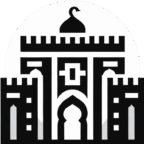Tangier-born Moroccan traveler Ibn Battuta stands among history’s most renowned explorers. At age 21 in 1304 Ibn Battuta started traveling over three decades that stretched across 75,000 miles. His famous travel memoir The Rihla narrates his long journeys through North Africa followed by extensive exploration of the Middle East and across Asia and China. Through his observations Ibn Battuta demonstrated the wide-ranging diversity of cultures and beliefs and landscapes across the medieval world. He continues inspiring both travelers and scholars throughout present times.
Ibn Battuta’s Early Life in Tangier
Within Islamic Morocco’s Tangier city his family settled among legal scholars. Battuta developed his initial interest in scholarly exploration as well as travel because his family nurtured Islamic law and education since childhood. Tangier as a port city introduced him to stories about distant lands which created in him a relentless fascination to personally explore the world.
Before beginning his first significant journey, he started his travels at the beginning of his life.
When he turned twenty-one, Ibn Battuta began his journey to Mecca in 1325. His travel would create life-changing developments that established the groundwork for his research. Before embarking, he planned to complete his spiritual obligation through the pilgrimage, but this foundational trip ignited a fervor for learning about unfamiliar lands and peoples. His pilgrimage journey stimulated further extensive traveling, which led him to explore regions extending past Arabia. Modern travelers limited themselves to destinations that they explored beyond their reach during this era.
Ibn Battuta’s Remarkable Routes Across Continents
During the years of his travels Ibn Battuta experienced nearly every significant geographical region of his era which signified both his daring character as well as his academic inquisitiveness. The destinations in his worldwide expedition were split into multiple primary locations through which he undertook significant cultural encounters as well as recordable observations.
The region of North Africa and the Middle East became part of Ibn Battuta’s travel map.
His travels extended through North Africa into the central sections of the Middle East regionDuring his journey he stopped at Egypt to look at the Great Pyramid of Giza and to discover Cairo’s urban excitement. During his journey from Palestine through Jerusalem to Damascus he witnessed different cultural and religious features in each location.. Through his historical accounts, he examined the architectural features, social patterns, and political structures of these places, which taught us essential details about medieval Islamic societies.
The path guided him through Asia’s endless heartlands
Upon finishing his Mecca pilgrimage, Ibn Battuta began his eastern expedition. During his journey through Iraq and Persia the traveler reached an endpoint in Delhi where he took up a post as judge within the Sultan of Delhi’s court. His rigorous examination of the Delhi Sultanate documents both the impressive architecture of the period as well as the multilingual nature of India at that time. During his expedition through the Indus Valley region, he made note of the traditions practiced by inhabitants, their religious beliefs, as well as the geographical features of their country.
The process of exploring China together with Southeast Asia became one of his signature achievements
During his travels Ibn Battuta studied the impressive infrastructure and trade practices which he observed in China.. His travels in Southeast Asia, including the Maldives and Sri Lanka, further broadened his understanding of diverse cultures and religions. Ibn Battuta marveled at the bustling trade routes and described the people, foods, and customs he encountered in these far-off lands.
Legacy of Ibn Battuta’s Writings
Ibn Battuta wrote his travel accounts into the Rihla (The Journey). Ibn Battuta generated an exceptional historical document regarding medieval societies that enables readers to view the 14th century with original perspective.
The Rihla: A Treasure Trove of Historical Knowledge
The Rihla is considered one of the most significant travelogues in history. Through his writings, Ibn Battuta captured details of the customs, governance, economies, and religions of the places he visited. Historians rely on the Rihla to better understand cultural exchanges and connections between regions in the medieval Islamic world. Through his detailed observations of worldwide communities, Ibn Battuta allowed future researchers a view into lost historical realities.
Ibn Battuta’s wisdom serves modern travel enthusiasts by simultaneously contributing to scholarly investigations.
Throughout present times we honor Ibn Battuta through various commemorative celebrations. The Rihla proofs critical for historians alongside anthropologists benchmarking Islamic expansion and trading systems and cultural interactions from the 14th century..People automatically think of adventure and discovery when they hear his name because he inspires others to step outside familiar boundaries while experiencing multiple cultures. Today’s travelers praise Ibn Battuta as an early leader of cultural exchange because his curiosity resulted in a closer global connection.
Ibn Battuta stands as a central figure in contemporary Moroccan social life.
Ibn Battuta’s contributions are honored in Morocco through various monuments and places dedicated to his legacy.
Monuments and Tributes in Tangier
A transport hub named Ibn Battuta Airport at Tangier brings visitors from around the world to the place of his birth. Visitors can explore Arabian explorer Ibn Battuta’s life through the permanent displays at the Ibn Battuta Museum in Tangier. The museum allows visitors to follow Morocco’s most significant explorer’s footsteps.
Conclusion
Historical cultures in Morocco demonstrated deep interconnections through the many stories of travel which Ibn Battuta related. Through his brave and curious nature he built lasting cultural ties which future generations could construct upon.Through his story we find inspiration to study different cultures while accepting multiculturalism and embracing world exploration today. The medieval world remembers Ibn Battuta as a legendary figure because he unified Tangier to China and beyond through his varied observations and endless wanderlust spirit.
External Sources for Further Reading
- The Travels of Ibn Battuta – The British Library
- Ibn Battuta’s Rihla: An Epic Journey of Discovery – World History Encyclopedia

